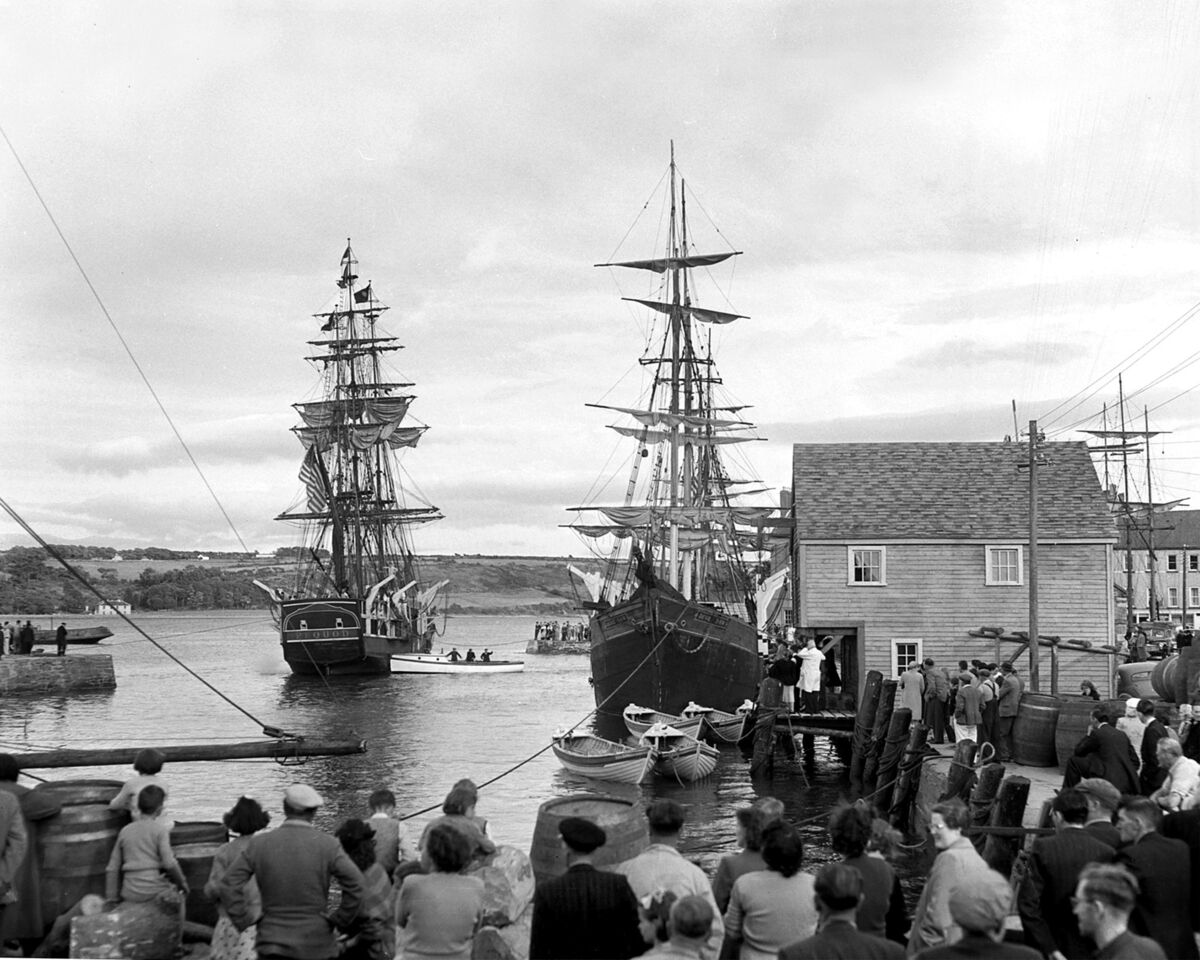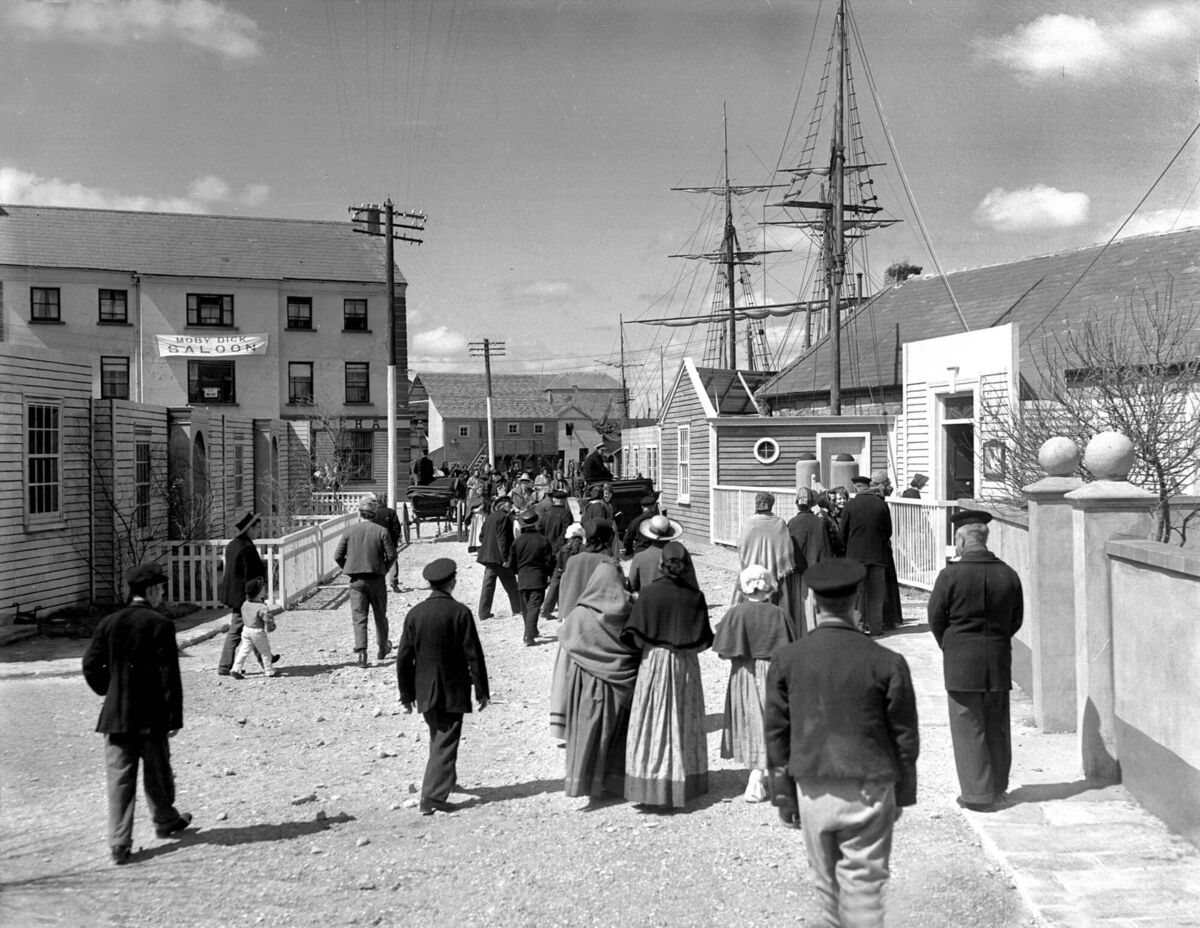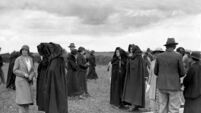70 years ago... a whale of a time in Youghal as Moby Dick is filmed

Actor Gregory Peck signs autographs on the set of the film 'Moby Dick' at Youghal on July 29, 1954
IN 1954, times were hard. Corkman William Dwyer had thrown Youghal a lifeline by starting a cloth manufacturing plant, Seafield Fabrics, in 1947. Then, in 1952, he opened Blackwater Cottons: 250 people were employed in the two plants.
But unemployment and emigration were still rife. Into this drab backdrop, in the summer of 1954, came the bright lights, glitz and glamour of Hollywood.
The famous film director John Huston was entrusted by Warner Brothers with a million dollars to make a film based on a book, Moby Dick, by Herman Melville, about a whaling captain in New Bedford, Massachusetts in 1851, seeking revenge on a whale - ‘Moby Dick’ - that had eaten his leg off.
Youghal was chosen as one of the sets. Why? Firstly, Huston was friendly with journalist Claud Cockburn, who lived locally. Then you had the unspoilt scenery of the harbour.
As one looks out from the lighthouse, there is nothing on the far side of the river to ‘date’ the area - no pylon or pole to be seen. Plus, the old sailors wandering around the quayside with their white beards blowing in the wind were ready-made for parts in the film.
Huston would visit Cockburn at his house, Brook Lodge, about a mile outside Youghal, which was shabby and in disrepair. Claud told me a funny story about one wet day when Huston visited. They sat - having a drop of whiskey - in the parlour with both holding a large bowl on their laps to catch the rain coming through the ceiling.
“Imagine that!” said Claud. “And remember that John had a cheque in his pocket at that time from Warner Brothers for a million dollars.”
In February, 1954, a local builder, Michael Murray, was doing renovations to houses on the quay when a big car stopped beside him. Several well-dressed men alighted to walk the quays - seemingly looking for something. It was too much for Michael, his curiosity got the better of him. He offered to help and was told a film would be made there that summer.
The visitors asked if Michael would like to make the sets, and took his phone number. His workmen didn’t believe him - they did three months later! He got the gig to erect imitation houses, paint existing houses and plant telephone poles in the ground to resemble ship masts.

These were fitted with cross-members and sails to make it look like dozens of tall-ships were in port. Actually, just four real tall-ships docked at the quays: the Ryelands - the Pequod in the film - Three Brothers, James Postlethwaite and Harvest King.
The preparation of the set - covering two blocks - gave employment to many: painters, carpenters, sailors and handymen. Huston did not spare the money, the whole town gained directly or indirectly.
Ten full trains of people came every day from Cork to see the film set and hoped to see one of the stars and maybe get an autograph.
There were 11 hotels in Youghal then - the Imperial, Stella Maris, Devonshire, Green Park, Park View, Adelphi, Harbour View, Esplanade, Atlantic, Pacific and the Marine - but the star of Moby Dick, Gregory Peck, chose to stay at the Metropole Hotel in Cork city. The other stars included Richard Basehart, Orson Welles, Noel Purcell and Royal Dano.
Many locals played extras. I was ten, and landed a bit part with my eight-year-old sister, Eileen. We had to walk into church holding the hands of a woman pretending to be our mother. I walked into that church to find it had no roof - it was only a false front for the camera - and overhead was a pure blue sky.

In another scene I recall, Basehart was going from tavern to tavern, seeking a captain to take him on as a crewman. It was a very wet scene and he was soaked because behind the cameras the local fire brigade was firing water from four hoses up into the air.
Welles, as Father Mapple, gave a sermon from a pulpit that ran for eight minutes, and managed it in one ‘take’ - much to the delight of the crew, who loudly applauded.
A young Cork girl, Clodagh Madden, 10, used to come with her six-year-old brother every summer to stay with their aunt in Strand Street. In 1954, they raced to the Town Hall to audition as extras, unaware the queue was at the back. A kindly security guard let them skip the queue and they were taken on.
Adult extras got £2 per day, children 15 shillings. It was a lot in 1954, for walking around the quayside for a couple of hours.
Paddy Linehan’s was a small bar and butcher’s that Paddy renamed Moby Dick’s afterwards. He got £5 a week for allowing cast and crew use a small room for daily 6am meetings. And the Americans loved port wine. Paddy joked he sold as much of it that summer as would float the Pequod!
The landlord told a story about Huston looking for an attractive girl to kiss a sailor goodbye as a vessel left the quayside. A lovely red-head working in the bar agreed to do it. It needed eight ‘takes’ and she got £8 for her troubles. A pound per kiss, and Paddy paying her just one pound ten shillings per week!
She resigned her bar job and went off to Hollywood to seek her fortune - but we never heard anything after. When I was giving a talk on Moby Dick in Dungarvan some time ago, someone asked if that girl could have been Maureen O’Hara - but we never heard that Maureen had worked for Paddy Linehan.
A local character, Rosaleen Cronin, was a great swimmer and fan of Peck. She kept being thwarted as she sought his autograph so swam up on him while he was filming a scene and shouted “Can I have your autograph?!” The folk across the dock roared with laughter and filming had to be adjourned for the day.
Some of the male ‘extras’ wore the whaler clothes they had been given all the time. One, a chap called Noel, chatted about the film to an Italian tourist, and was delighted to receive a tip of a 10,000 lire note. Sadly, he soon fund out it was only worth one pound and a few shillings.

Another story publican Paddy told was of a local pretending to be the actor Richard Basheart when an American woman was looking to meet him. When she asked him for his autograph, he turned to Paddy and asked: “How do you spell Basehart?”
The making of the film progressed steadily during what was a lovely, fine summer, and thousands of onlookers and tourists kept thronging the quays and nearby streets and lanes.
There were two cinemas in Youghal then - Horgan’s and the Regal - but this was a taste of Hollywood on our doorstep.
One of the ‘props’ on the quayside was a real old goat with big horns.
In late August - as the action was coming to an end - it was decided to have a Celebratory Ball in the Showboat Ballroom with the Mick Delahunty orchestra. Word went around the town that one of the famous film stars would appear on stage to thank the townspeople for their hospitality and help. Everyone assumed it would be Gregory Peck, but at midnight, Mick Delahunty played the ‘star’ onto the stage - and it was the old goat with the big horns. A last laugh to finish the celebrations!
When Moby Dick was shown in the town’s cinemas a few years later, there was such cheering and laughter that a world of ushers would not be able to keep them quiet.
Even now - almost 70 years later - folk are still arriving in Youghal to see where Moby Dick was filmed.
The next time you visit, note the remarkable stone statue of Captain Ahab standing with harpoon in hand, on the quayside beside the tourist office.
This story, and many more, appear in The Years Of The 4 nostalgia supplement, FREE with The Echo on Tuesday, January 2.







